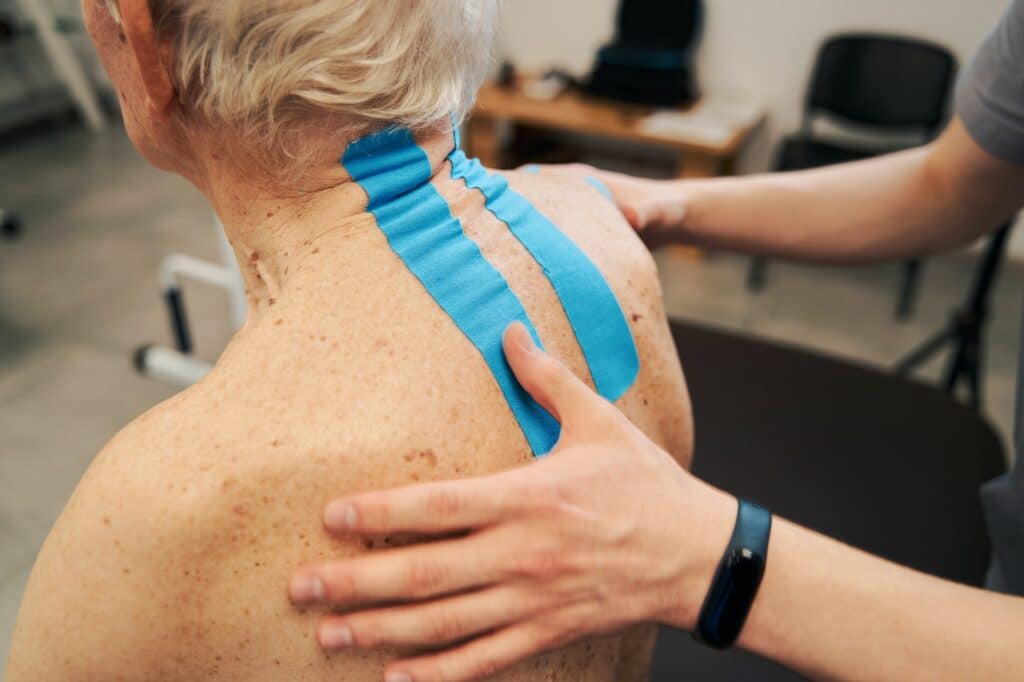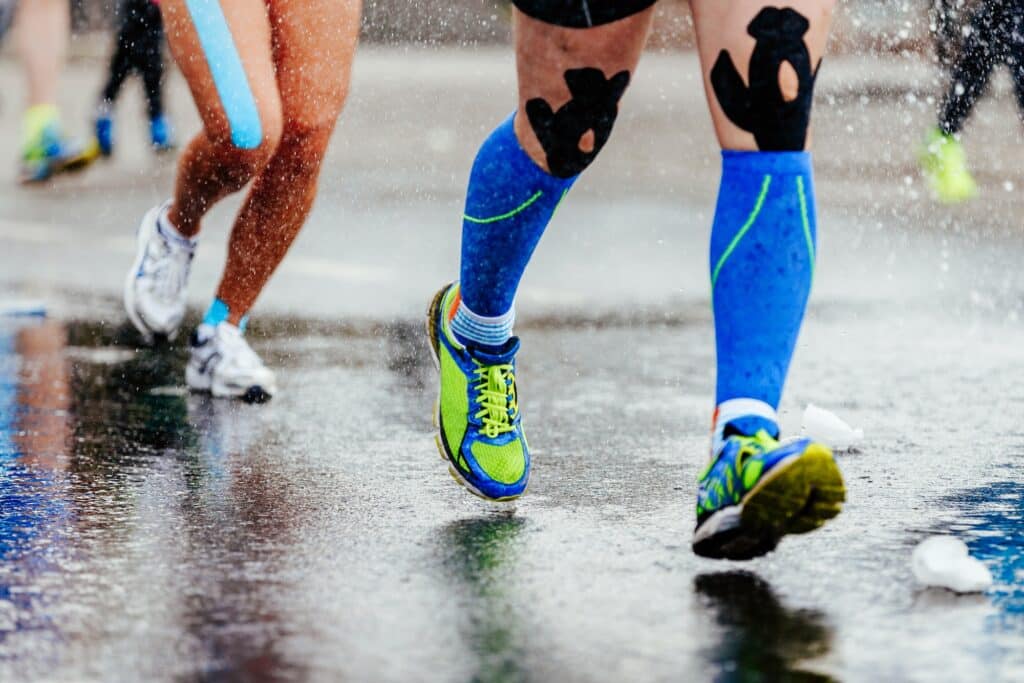

At Physio Ed, we are committed to providing you with trusted and reliable content on health and wellness topics. Our content creation and editing process is rigorous and transparent, and here is how it works:
We value your feedback and questions, and we are always happy to hear from you. You can reach us at info@physioed.com. Thank you for choosing Physio Ed. as your trusted source of health and wellness information.
Whether swimmers, basketball players, or golfers, it’s common to see famous athletes with large strips of colorful athletic tape on various areas of their bodies. You may also wonder what this strange technique does and how it benefits them—or even how it might benefit you.
Physical therapists often apply elastic therapeutic tape to aid an athlete’s range of motion and blood flow or to relieve pain, reduce swelling, and treat sore muscles.
Kinesiology tape (sometimes referred to by brand names like Kinesio Tex Tape or KT Tape) can be incredibly useful for athletes and non-athletes alike, especially when appropriately applied and in the proper context.

Kinesio tape is a specific type of elastic tape made of cotton and polyester. Unlike other tapes, kinesio tape can stretch when applied to the skin. It is hypoallergenic and latex-free, and therefore typically safe for sensitive skin.
When applied, you can leave the tape on for several days. It is even okay to get wet, taking 5-10 minutes to dry. (1)
There are several theories behind why kinesio taping works. The mechanical stimulus of applying the tape with some degree of stretch can lead to responses from multiple levels of the body, including the skin, fascia, lymphatic system, circulatory system, and brain. (1)
Stretching on the skin can stimulate mechanoreceptors which helps the brain adapt pain signals. It can also move the skin upon the deep fascial tissue layers below, allowing for reduced fascial tension. Finally, it can reduce pressure on the vascular system to enable open valves which can help with swelling. (1)
Tape can also help an injured area of the body or joint by applying pressure in specific patterns to relieve pain or provide support to a weak area. (2)

Kinesio taping can benefit a wide range of people of all ages and activity levels. It can help improve pain from new and old injuries, including arthritic joint pain. It has also been shown to help reduce swelling, and improve posture and balance. (2)
However, kinesiotaping is not for everyone. There are several conditions in which kinesio taping is not recommended, including certain active cancers, infections (like cellulitis), open wounds, blood clots, or prior allergic reactions. (1, 2)
Other conditions are considered precautions for kinesio taping, which you should check with:
Be sure to check with your doctor if you have any of the following conditions, as they are also considered precautions for kinesiology tape application:
Diabetes or neuropathy
Congestive heart failure
Kidney disease or need for dialysis
History of an organ transplant
Skin sensitivity

The foot and ankle significantly affect your stability when walking or standing. Weakness in the ankles, poor coordination, and stiffness in the joint can all impact your overall balance and increase your risk of falls.
Several studies have looked at the benefits of kinesio taping on the ankle and balance with mixed results. A few studies showed improvements in balance and walking after wearing the tape for 48 hours, up to two weeks at a time. More importantly, these improvements were maintained as many as three days after removing the tape. (3, 4, 5)
The idea behind tape is that it is meant to help improve the brain/body connection (neuromuscular coordination) to support the ankle joint and keep it from rolling or giving out. It theoretically keeps the foot in the proper position to increase contact with the ground. (3, 4, 5)
However, one other study examining the effects on older women found no change in the overall balance after 48 hours of the tape. It is important to note that different methods and techniques were used when applying the tape, and every person will react differently. (6)

Due to the high prevalence of knee arthritis in older adults, many studies have also examined the effects of kinesio taping on the knee to help manage pain and improve walking.
One study found an immediate reduction in knee pain with walking, showing improved balance on a walking test after applying tape to the affected knee. (7)
Another study utilized exercises with varied taping techniques, showing similar improvements in pain and function. After three months of training, the group that used the taping methods had more significant improvements than those that did not. (8)
How kinesio tape is applied will vary greatly depending on your injuries, pain, and weakness. It is best to consult a trained physical therapist if you have pain, joint swelling, or instability to find the best technique for your needs.
Taping to help with joint stability typically requires stretching the tape in specific patterns to keep the joint in alignment or take pressure off a painful part of the joint. A common one used for knee pain and stability requires only two pieces of tape.
Start with your knee in a bent position. Place the tape without any stretch about 3 inches below the knee cap. Rub the tape to make it warm (activating the adhesive). Pull the tape with about 10-15% of its stretch capacity outside the knee cap. Anchor the tape in the center, about 2-3 inches above the kneecap.
Repeat this process with the 2nd piece of tape running along the inside of the kneecap with the same start and endpoints. (9)
Similarly, taping to improve ankle stability will require using the stretch feature of the kinesio tape. The following technique is helpful for those with weak ankles or who tend to roll their ankle often.
Start with your leg out straight, and your ankle flexed (pulling your toes towards your nose). Place the tape slightly above the bony bump at the inner part of your ankle. Stretch the tape fully, pulling it across the bottom of your foot and anchoring it above the bony bump outside your foot.
Next, place a new piece of tape below the bony bump on the inside portion of the foot (on the heel). Stretch the tape about 50% and pull it around the back of the heel, then loop it under the arch of the foot. Anchor this piece on the inner side of the midfoot.
Finally, repeat the step above but start on the outside of the foot. Go around the heel and across the bottom of the foot, anchoring on the outer side of the midfoot. (10)
Taping for swelling, in general, will not require stretching of the tape. This technique is typically performed by cutting 1-2 pieces of tape into long, skinny strands but leaving enough space at the top to anchor the tape without cuts.
For knee swelling, begin seated with the knee bent. Anchor the first piece of tape to the inner thigh, a few inches above the knee. Then run the long strands down along the knee joint in a diagonal pattern with minimal to no stretch on the tape.
Next, repeat this same technique but starting with the anchor point on the outer thigh, a few inches above the knee. Lay the long strands diagonally (moving inward) across the previously placed tape. (10)
Kinesio taping has been shown to benefit people across all age ranges and activity levels.
When applied correctly, it can help with pain reduction, swelling, joint stability, and even balance. Generally, taping is safe for most individuals but talk with your doctor if you have any of the conditions mentioned above before use.
Talk to your physical therapist if you have more questions regarding taping techniques and if kinesio taping may be right for you and your injuries.
Physiopedia. Kinesio Taping. https://www.physio-pedia.com/Kinesio_Taping
Orthopaedic Associates. Benefits of Kinesiology Tape. https://www.oaidocs.com/2018/09/14/benefits-of-kinesiology-tape/#:~:text=Kinesiology%20tape%20stabilizes%20the%20injured,move%20along%20with%20the%20body.
Jackson, K., Simon, J. E., & Docherty, C. L. (2016). Extended use of Kinesiology Tape and Balance in Participants with Chronic Ankle Instability. Journal of athletic training, 51(1), 16–21. https://doi.org/10.4085/1062-6050-51.2.03
Saltan, A., Baltaci, G., & Ankarali, H. (2019). Does Kinesio® taping improve balance and functional performance in older adults? A pilot study. The Journal of sports medicine and physical fitness, 59(8), 1346–1352. https://doi.org/10.23736/S0022-4707.18.09207-1
Rogers M et al. Effects Of Kinesiology Tape On Balance. (Abstract). Med Sci Sports Exerc. 2016. 48(5):S109.
Li, P., Wei, Z., Zeng, Z., & Wang, L. (2022). Acute effect of kinesio tape on postural control in individuals with functional ankle instability following ankle muscle fatigue. Frontiers in physiology, 13, 980438. https://doi.org/10.3389/fphys.2022.980438
Park, J. S., Yoon, T., Lee, S. H., Hwang, N. K., Lee, J. H., Jung, Y. J., & Lee, G. (2019). Immediate effects of kinesiology tape on the pain and gait function in older adults with knee osteoarthritis. Medicine, 98(45), e17880.
Castrogiovanni, P., Giunta, A., Guglielmino, C., Roggio, F., Romeo, D., Fidone, F., Imbesi, R., Loreta, C., Castorina, S., Musmeci, G. The effects of exercise and kinesio tape on physical limitations in patients with knee osteoarthritis. Journal of Functional Morphology and Kinesiology. 2016, 1, 335-368. doi:10.3390/jfmk1040355
Performance Health Academy Network. Myofascial Treatments and Kinesiology Taping Techniques for Knee Osteoarthritis – YouTube
Gibbons, John. A Practical Guide to Kinesiology Taping. Lotus Publishing; 2014. Pg. 37-38, 111-112.

Keep in mind that we may receive commissions when you click our links and make purchases. However, this does not impact our reviews or recommendations. We prescribe the same equipment to our patients in the clinic. We always try our best to keep things fair and balanced, in order to help you make the best choice for you.